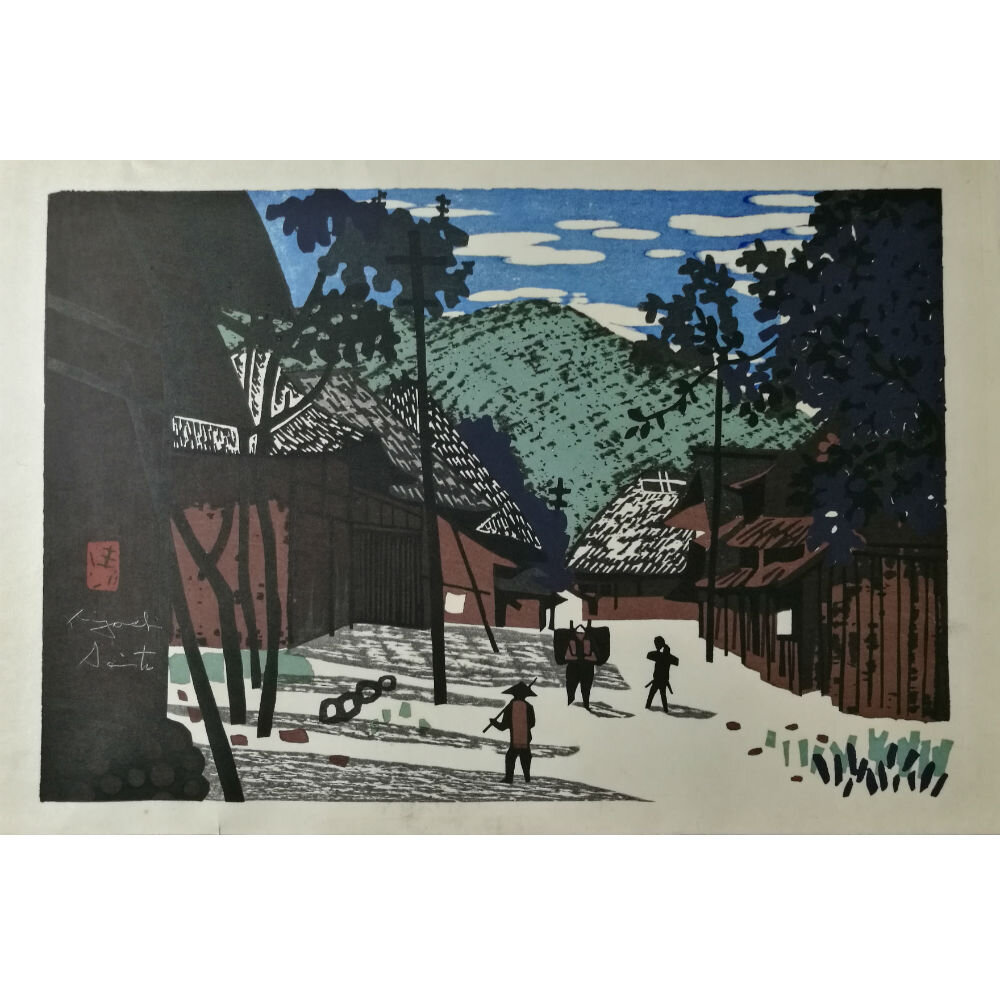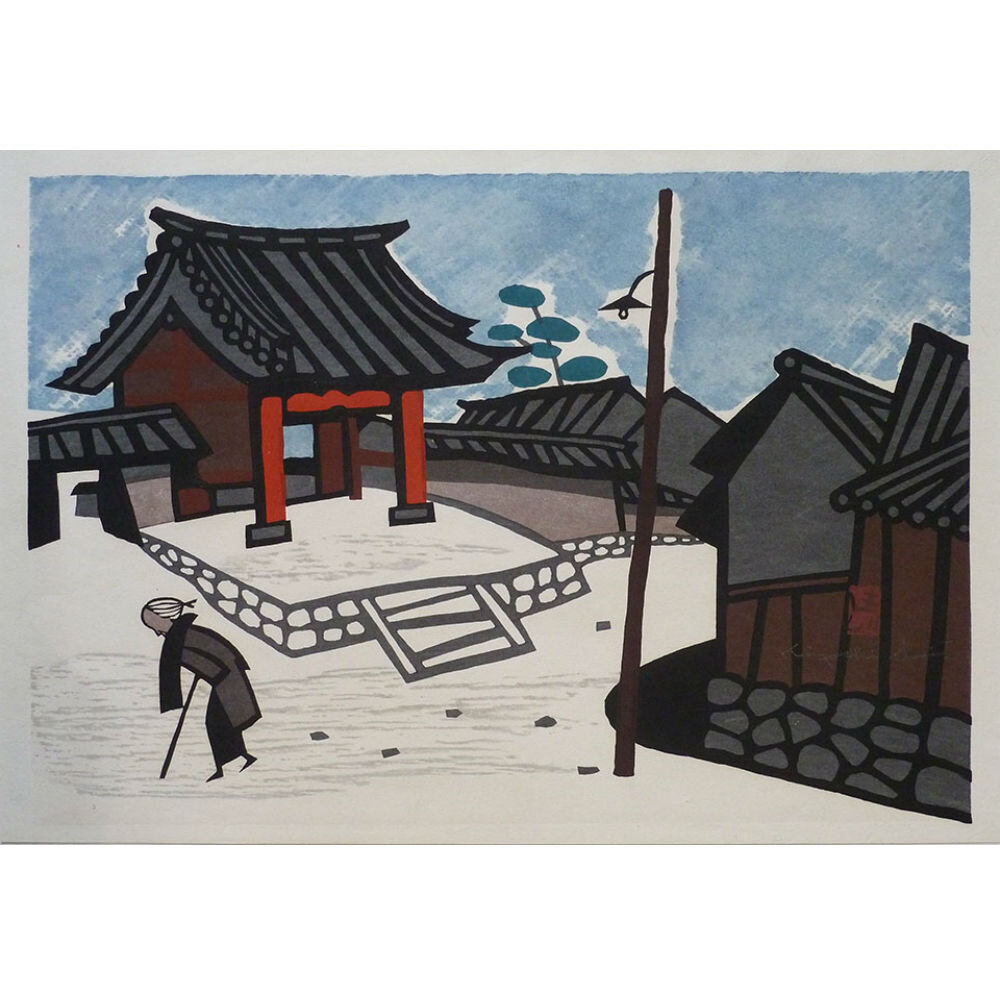斎藤清 KIYOSHI SAITO (1907-1997)
Most recognised for his “Winter in Aizu” series and his landmark works “Milk” and “Steady Gaze” for their role in his post-war breakthrough; Saito’s prints elicit varying senses of mood and emotion through large tones of colour, subtle use of shadow, and “Mokume-zuri” (wood-grain printing). A resilient and self-taught artist, having drawn from European influence, Kiyoshi Saito’s prints are now internationally renowned.
A true master of twentieth Century creative printmaking, Kiyoshi Saito is decorated with Japan’s highest honours for his distinguished contribution to Japanese arts: The Order of Sacred Treasure and The Order of Culture.
Latest News: Kiyoshi Saito: The inspiration behind 2016 stop-motion masterpiece - Kubo and the two strings.
Artist Biography:
Kiyoshi Saito was born in Aizubange, Fukushima prefecture, in 1907.
Saito’s early childhood was one of relative poverty; with his father’s business failing, the family found themselves moving north to Hokkaido in 1911. Japan’s rate of industrialization was continuing to accelerate at this time; with western expertise, and a new demand for Japanese exports (driven through the support of European allies in the Great War), there was a need for coal. As such, the family’s move to Yubari lay on the opportunity for Saito’s father to find employment in the surrounding Ishikari coalfields.
However, in 1920, at the age of thirteen, Saito’s mother sadly died and was subsequently sent to live under the guardianship of a Buddhist temple. Allowed to return home after a quashed escape attempt, Saito looked toward his fondness for painting as a means of security. Finding an apprenticeship in Otaru as a sign painter - the apprenticeship offered a degree of financial stability over the next few years whilst Saito dabbled in, and dreamt of, becoming an oil painter. By the time he was twenty, Kiyoshi Saito had established his own successful, and stable, sign-painting business.
Nevertheless, Saito could not escape his passion for art. Famous European artists such as Norwegian painter & printmaker Edvard Munch (1863-1944) and French post-impressionist painter Paul Gauguin (1843-1903), were such influential figures to the effect that in 1932 he sold his business and moved to Tokyo. Focussed on studying Western-style painting at the Hongo Painting Institute, Saito soon took to exhibiting his oils - his first at the ninth Hakujitsukai Art Exhibition that same year.
Exposed to new, wider, & established art communities in the city; Saito drew new inspiration from other respected and prominent artists of the time. Sotaro Yasui (1888-1955) who was similarly an oil painter, and who largely drew from Western style portraiture, introduced Saito to the idea of woodblock printing. Saito had great admiration for his skill and landscape design and began to experiment in the medium himself. Continuing to paint,but growing frustrated in the lack of recognition for his oils, Saito produced, and exhibited, his first woodblock print in 1936 at the fifth Nihon Hanga Kyokai (Japanese Print Association).Turning his focus increasingly toward printmaking, Saito never found a formal teacher to guide him in the processes and techniques involved in the craft. Self-taught, Saito’s early methods leant on prints being cut and reduced from a single carved block, often resulting in single copy editions. Consequently, it was not until 1939 when Saito was introduced by Tadashige Ono (1909-1990) to the Zokei Hanga Kyokei (Plastic Print Association), which he then joined, that he truly understood the possibilities of using multiple woodcut blocks to create numerous copies of one image.
Working with water based and sumi inks, Saito printed with a chosen Echizen Hosho (mulberry paper) traditionally crafted in Fukui Prefecture. Employing his admiration for Munch’s use of wood grain in his relief prints, Saito’s work continued to evolve from European influence, and notably their impressionist & modernist qualities. Printing from“katsura” blocks in his early career, to ply-faced “shina” and other Japanese woods; the majority of Saito’s most successful impressions settled on “keyaki” blocks due to its broader grain. An intrinsic design element to his work, Saito further utilized large flat tones of colour together with a subtle use of shadow to elicit varying senses of mysticism, solitude, and emotion. His designs often subtly echoed the modernisation of Japan.
Forging his own distinct style, by 1940, Saito had produced his first “Winter in Aizu” series - scenes from his early childhood hometown that would become one of his favourite and most recognised subjects throughout the course of his life. Saito continued to exhibit his Aizu series during the Second World War and it was during this period that he worked for the Asahi Newspaper Company. It is difficult to ascertain his exact war-time role for the paper, however his printmaking did not take a back-seat despite the lack of materials and heavy censorship which he & other Japanese artists in general, faced at the time. On the contrary, through the role he met famed artists Shiko Munakata (1903-1975) and Koshiro Onchi (1891-1955). Both offered Saito exposure to a broader array of exhibitors, galleries, & wider support network of similar young artists. Through Onchi’s Ichimokukai (First Thursday Society), Saito joined a founding group to the later recognised “sosaku hang”a movement, which other renowned artists such as Umetaro Azechi (1902-1999) and Gen Yamaguchi (1896-1976) -all who met once a month to discuss their print- were apart of..
By 1954, Saito’s printwork had transitioned toward an air of simplification and had begun to focus on calm, simple expressions of design. Demand for his pieces had increased spectacularly. The style and subject of Saito’s pieces appealed to occupying American forces and, reinforced by an 1948 American-led exhibition in Tokyo - Salon Printemps -, the success of first prize for a print entitled “Milk” brought tremendous exposure to foreign collectors. Furthermore, by this time, Saito had shaken the domestic disregard his countrymen held for his pieces. In 1951, Saito and his compatriot Tetsuro Komai (1920-1976), won first prizes for their respective print “Steady Gaze” and etching “Momentary Illusion”. Exhibited at the First Biennial Exhibition in Sao Paulo, their pieces were recognised over traditional sculptural and oil paint mediums; extinguishing animosity the Japanese art community held toward Saito and the establishing creative “sosaku” print movement.
Exhibiting across Europe, Asia, and the US in the following years, appreciation for Saito’s commitment to his craft grew. Recognised as a true master, Saito was honoured with an invitation to sketch Prime Minister Eisaku Sato in 1967, before being decorated with Japan’s highest honours: the Order of Sacred Treasure in 1981 and the Order of Culture in 1995. Despite the attitude of critics toward Saito prior to his award in Brazil, Saito held no animosity - graciously donating many of his works to museums in Japan and around the world.
Supported by his loved ones: Katsuyuki Ohtsu (1935 -) - his assistant for over forty years -, a daughter, Naoko, and his wife who he lived with in Kamakura, Tokyo, until her death in 1987, Saito later returned to Aizu where he spent the last decade of his life. Continuing to produce prints in his private studio, Saito lived to see the opening of a Museum dedicated to his life and works: The Kiyoshi Saito Museum of Art in Yanaizu, Fukushima, before passing away the same year at the age of ninety in 1997.
b: 27/04/1907 - Aizubange, Fukushima Prefecture, Japan.
d: 14/11/1997 - Tokyo, Japan.
Written by: Jack Payne | © Lambsquay Gallery
BIBLIOGRAPHY/ARTICLES:
Kiyoshi Saito Museum of Art Yanaizu: https://www.town.yanaizu.fukushima.jp/bijutsu/en/about/profile/
Statler, O., 1959. Modern Japanese prints: an art reborn, Charles E. Tuttle Co.,: Rutland, Vt.
Till, B., 2013. Masterful images: the art of Kiyoshi Saito, Portland, OR: Pomegranate Communications, Inc.
Callander, J., The hands of the artist: KIYOSHI SAITO. Japan Living Arts by Steve Beimel. Available at: https://japanlivingarts.com/the-hands-of-the-artist-kiyoshi-saito/:
Hendricks Art Collection: http://www.hendricksartcollection.com/saito.html



